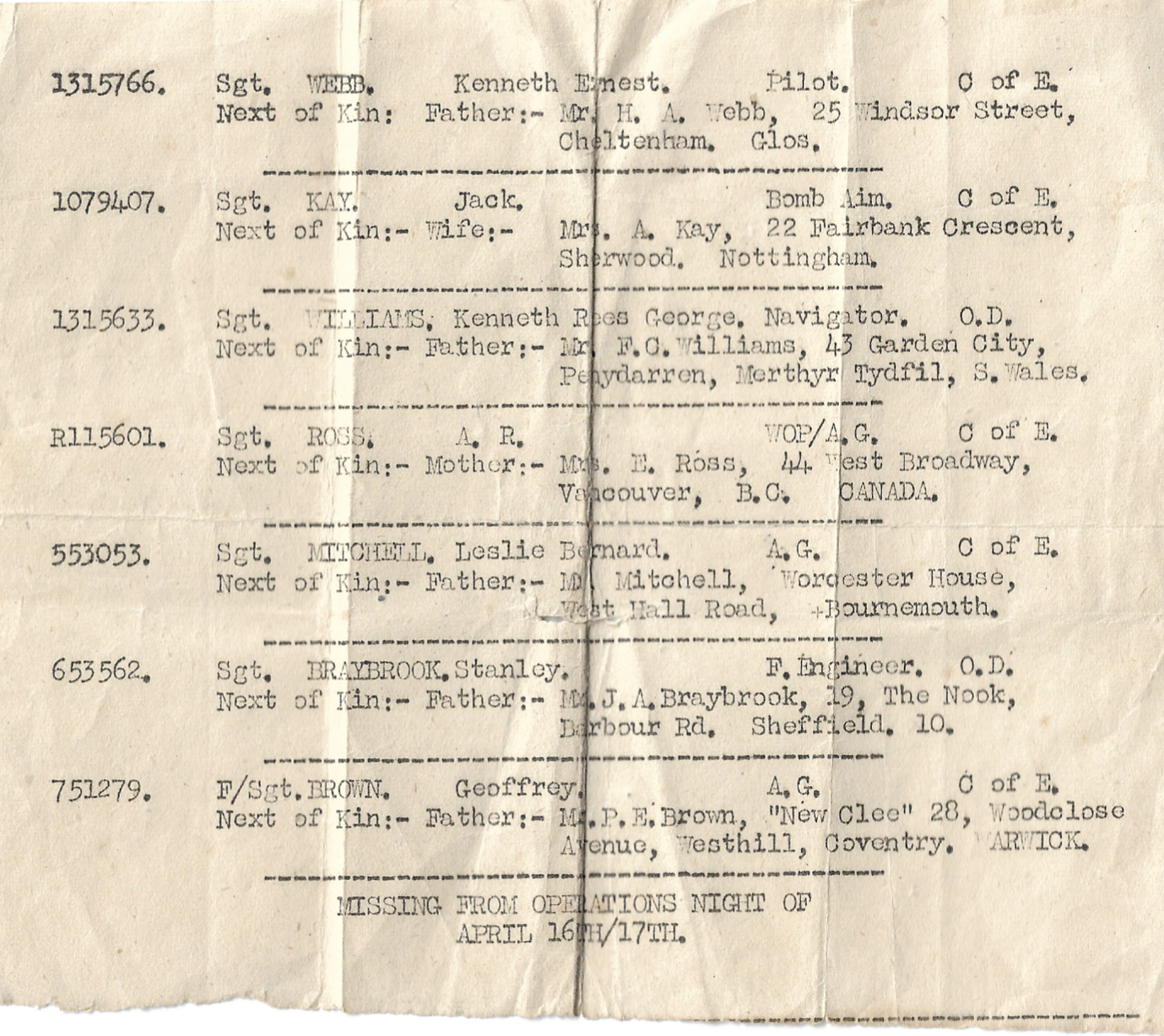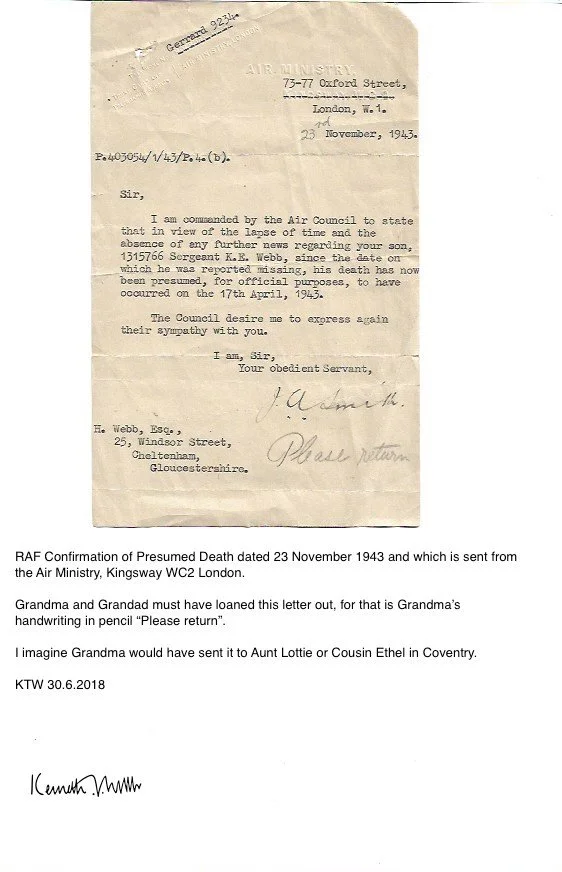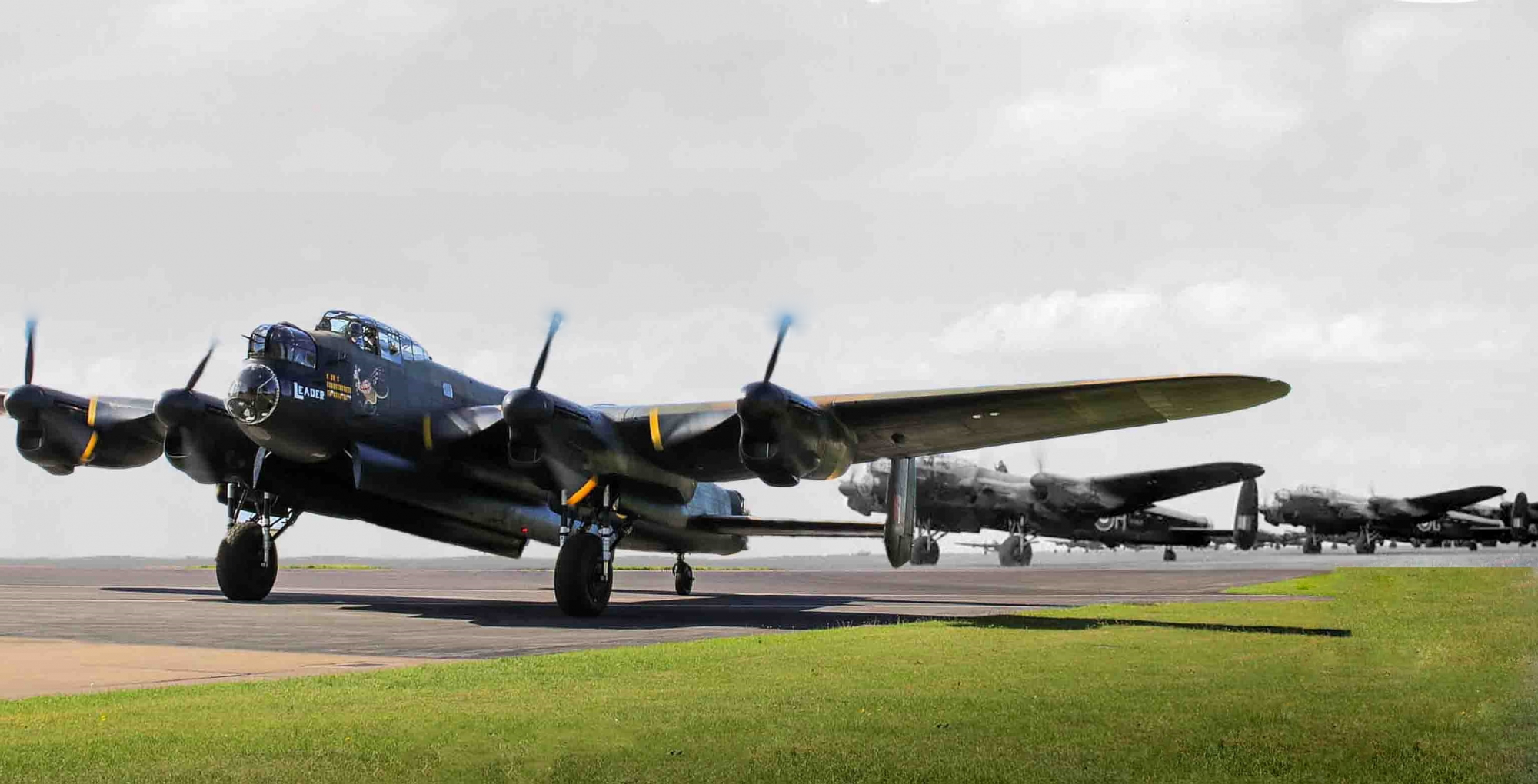RAF 77 The RAF Adjutant's Office in Wartime ~ 1939-1945

Royal Air Force
RAF 77 The RAF Adjutant's Office in Wartime ~ 1939-1945
Preamble
Letters on a Desk
I look about me. Letters on the desk. RAF correspondence from squadrons to family; a pencilled letter in haste between a mother and her sister conveyed by post. Simultaneously, a teenager swiftly dispatched to catch the evening train to Coventry, to arrive in time for the letter posted that morning; then the firm parental the instruction to “quickly borrow the bicycle”, cycle the 11 miles from Coventry to Leamington Spa, “to be there before Bert arrives home”, so this teenager can break the news in person that his own elder brother is reported missing.
“This teenager” ~ Desmond Budd Webb (1927-2012), my father.
Original manifest from 76 Squadron records prepared by the Squadron’s Adjutant. These were sent to the families, and this enabled families to contact each other. As a former peacetime adjutant and a later junior Probate and Trusts lawyer, I vouchsafe that this was indeed an impressive decision by high command and endorsed by central government.
The Scene
I am seated in our father’s study in 2012. I look about me. Letters on the desk. Letters from the last century ~ April 1943. RAF correspondence from squadrons to family; a pencilled letter in haste between a mother and her sister (our grandma and great aunt aunt) conveyed by post. Simultaneously, and with suddenness we find a teenager swiftly dispatched to catch that same evening’s train to Coventry, to arrive in time for the letter posted that same morning; then the firm parental the instruction to a sister-in-law to allow her nephew to “quickly borrow the bicycle”, as he will then need to cycle the 11 miles from Coventry to Leamington Spa, “to be there before Bert arrives home”, so this teenager can break the news in person to his aunt and uncle that his own elder brother is reported missing.
On Station
The Royal Air Force was (and still is) known for its administrative efficiency.
As I look at the sheet from the squadron adjutant’s office, I can picture precisely - having been an adjutant - the hive of wartime activity; the large secretarial staffs across 31 RAF Stations, in twelve Counties, typing up lists of the fifty-nine aircraft overall that have failed to return that night to 33 Squadrons. The co-ordination between orderlies, secretaries and 33 adjutants (squadron leaders) keeping their 33 squadron commanding officers (the wing commanders) informed. Throughout, 31 station adjutants (wing commanders or squadron leaders) keep 31 station commanders (group captains) quietly briefed. These station commanders are in turn in constant liaison with Group Headquarters, High Wycombe in Buckinghamshire, their awareness that at this point edged, because they were in direct communication with the Group Adjutant who in turn is personally briefing the Air Officer Commanding RAF Bomber Command, Air Chief Marshal Sir Arthur Harris.
I’m especially touched by the release of the family addresses of the aircrew to all seven next of kin. This is clearly a directive from the top, a hope that this tiny gesture will bring comfort, enabling families to communicate directly with each other. I’ve not read about this, it is more a gut feeling.
To any Gen Z reading this, dismiss your natural assumption that communication is instant.
Picture a world in which, regardless of how Hollywood and film studios et al like to portray life in wartime Britain, we are still dealing with a Nation, as a whole, still 54 years from the Act of Devolution, living and acting as one nation, one people, and with an average of one private telephone in every other street - usually the taxi driver - so the public telephone kiosks you see around (today’s defibrillator points) were the lifeline the nation’s lifeline
Your typical average family
I was 17 in 1970 when I joined the police force. And because I lived over police headquarters, my parents finally were able to afford a telephone - this is Cheltenham three one three eight nine - how strange its dialling tone.
“Hello, Cheltenham-three-one-three-eight-nine …”
“Oh, Mum, you’re there, good! Is Dad there? I’ve got a flat battery and I’m stuck in Christchurch Road. Could Dad bring the jump leads?”
“DESSSSSSSS?” With that curious upward diphthong on the last five Ss … “It’s Ken. The battery’s flat again. Yep. Christchurch Road. Right, okay. Ken, Dad says he’ll be with you in twenty!”
“O, great Mum. Thanks. I feel so stupid, I’m in uniform!”
“Haha. You mean you don’t want to let the public know you are in the police and can’t fix your car!!!!?”
”Oh MUMMMM! It’s no laughing matter. This is serious!”
“Yes, of course, dear. Des, (walking past mum) Ken says it’s serious!”….
… and there’s that lovely sound of a private joke between Ma and Pa… little different to the same conversations 27 years earlier at the height of the war for millions of families.
In the villages above, it would simply be…
“Hello, this is Coberley-three-double-five, who’s speaking please?”
And the dialling tone really did sound like I was dialling directly into the late 1920s. Even now, the memory is warm and goose-pimply.
Searchlights over Koblenz 1944 ~ Digital Artwork by KTW 2022
Research
Reading the statistical reports together with the W R Chorley RAF Bomber Command Losses, I gain perspective when considering the loss of Handley Page Halifax DK165 MP-E ~ The Webb Crew ~ when I observe my own list of losses recorded by W R Chorley. I recapture those images of wartime operations boards and aircraft outbound and inbound, and then neither, because we see instead Missing.
These represent fifty-nine four engined heavy bombers. I have merely shown the aircraft type on this table, rather than the more detailed analysis that shows an Aircraft’s Mark.
I thus very quickly understand the loss of:
19 Avro Lancasters
21 Handley Page Halifaxes
8 Short Stirlings
11 Vickers Wellingtons
I always knew from my father that the loss was high...
Dad used to quote the newspapers reporting the attack the next morning, the headline underscoring fifty-five of our aircraft failed to return with a loss of 385 airmen.. When one likens that to conventional warfare on land and sea, it slowly dawns that this was the expected attrition, with life expectancy being four operations or raids.
Working through the family archive during the war years enables me to comprehend the size, scope and nature of total war.
The death rate that faced all of the services in wresting back from the savagery of fascism (today we call it populism) the freedom that, at least in Britain, the European Union, the great democracies of Australia, Canada and New Zealand, and of course, separately, the then USA, was paid for at a rate difficult to fathom. And I have not even mentioned the losses suffered by the then Soviet Union.
Archiving helps me to grasp the plight of civilian populations, worldwide, rarely if ever, mentioned in military biographies!
I think of the French City of Caen. I think of the very, very brief feeling of hope that the people of Caen realised that the Allies had landed in France on 6 June 1944, but which within hours had turned to unimagined horror when it was necessary for the Allies to pulverize the city - a vital link in the enemy’s supply lines, that cost the lives of 20,000 French civilians.
Then I draw a line back across the page of history and ring the name of one man ... and it serves us all to remind ourselves that it only ever takes one individual all the way down history since the dawn of time, to wreak havoc on otherwise peaceful peoples.
A Year On… 2022
It is now 2 November 2022. This was written in November 2021 and has remained in draft. It is an important chapter in the family’s story Windsor Street Days.
There is another even more important reason.
“Then I draw a line back across the page of history and ring the name of one man ... and it serves us all well to remind ourselves that it only takes one individual all the way down history since the dawn of time, to wreak havoc on otherwise peaceful peoples. ”
The War in Ukraine
The unprovoked Invasion of Ukraine by Russia at 3.59 am on Thursday 24 February 2022. Once again, I draw a line back across the page of current events ~ history in the making ~ and ring the name of one man.
What on earth must Vladimir Putin think when his name has become synonymous with Adolf Hitler?
“We MUST do all we can to help the people and Nation of Ukraine
in this grim and grievous hour,
for I have an awful feeling that history
will record this date
as the opening gambit
of World War III.”
Three Years on… 2025
In July 2025 we are beyond the opening gambit.
Mr Chorley reports that DK165 MP-E crashed between Lachen and Speyerdorf, 3 miles (5 km) SE of Neustadt. Those who died rest in Rheinberg War Cemetery.
Mr Chorley also confirms an interesting note that will, I know, be helpful to those who have an eye for technical detail. The Chorley team writes:
“The Mk II Halifaxes lost from 76 Squadron were the last of this type to be reported missing from the Squadron, while the Mk V was not only the first to be lost from 76 Squadron but is believed to have been the initial loss of its type on a bombing operation. Previous Mk V casualties had been from the Special Duty Squadrons based at RAF Tempsford.”
— W H Chorley Bomber Command Losses 1943
The excellent 76 Squadron Royal Air Force ‘and in the morning…’ by Barry Hope (published 2021) incorrectly states that DK165 MP-E was a Halifax Mk II.
“As part of the Royal Air Force Special Duty Service, the [RAF Tempsford] airfield was perhaps the most secret airfield of the Second World War. It was home to 138 (Special Duty) Squadron and 161 (Special Duty) Squadron which dropped supplies and agents into occupied Europe for the Special Operations Executive (SOE). 138 (SD) Squadron did the bulk of the supply and agent drops, while 161 (SD) Squadron had the Lysander flight, and did the insertion and pick-up operations in occupied Europe.”
— Handley Page Halifax From Hell to Victory and Beyond by K A Merrick
W R C
I confirm that the entry in the Chorley Record of Losses 1943, the correctly states Halifax DK165 MP-E as Mk V. The excellent 76 Squadron Royal Air Force ‘and in the morning…’ by Barry Hope (published 2021) states DK165 MP-E Halifax Mk II.
This often occurs with this statistical compilation, and I regard the Hope Work on 76 Squadron as an equally vital part of my RAF and aviation library. KTW 2025
The body of Sergeant Brown was found 17 miles from the crash site, and this would have been as a result of the attack on the rear of the aircraft. Sergeant Webb ordered Sergeant Mitchell to go aft to check on injury and damage. As Sergeant Mitchell arrived, the aircraft was hit immediately below the mid-upper turret, the aircraft breaking in two, both sections landing in woodland. Sergeant Mitchell later recalled the descent in the rear section, the design of the twin tailfins causing the tail to spin.
The rear section of the fuselage of DK165 MP-E broken amidships where the German soldier stands; above him, is the lower frame of the mid-upper turret, and it is from here that Sergeant Leslie Mitchell was rescued from. It is incredible to see that some of these young trees still stand. To the left off-cam would be the remains of the tail section of the Halifax Mk V.
In 2015, I was contacted by Herr Erik Wieman of IG Heimatforschung and his team via the Gloucestershire Echo. The article reported that the Halifax DK165 MP-E crash-site had been located in Lachen Speyerdorf woodland.
A monument to the Webb Crew has been erected at Lachen Speyerdorf in Rheinland-Pfalz.
2 July 2025
© 2025 Kenneth Thomas Webb
Ken Webb is a writer and proofreader. His website, kennwebb.com, showcases his work as a writer, blogger and podcaster, resting on his successive careers as a police officer, progressing to a junior lawyer in succession and trusts as a Fellow of the Institute of Legal Executives, a retired officer with the Royal Air Force Volunteer Reserve, and latterly, for three years, the owner and editor of two lifestyle magazines in Liverpool.
He also just handed over a successful two year chairmanship in Gloucestershire with Cheltenham Regency Probus.
Pandemic aside, he spends his time equally between his city, Liverpool, and the county of his birth, Gloucestershire.
In this fast-paced present age, proof-reading is essential. And this skill also occasionally leads to copy-editing writers’ manuscripts for submission to publishers and also student and post graduate dissertations.









